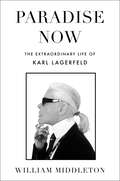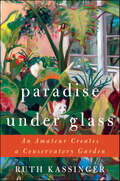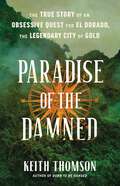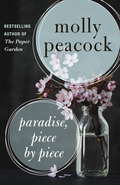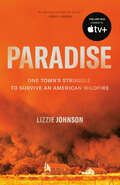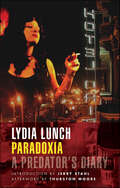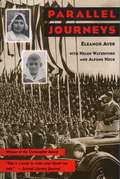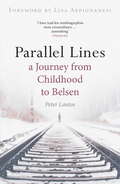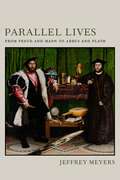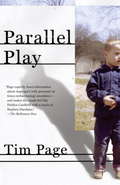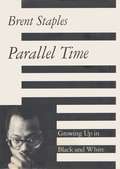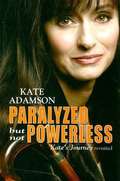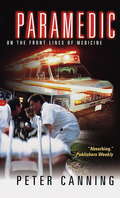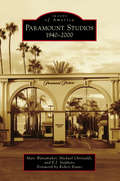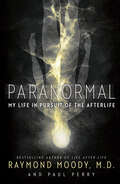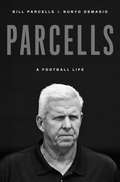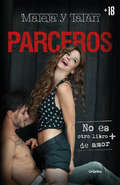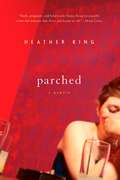- Table View
- List View
Paradise Lost: A Life of F. Scott Fitzgerald
by David S. BrownPigeonholed as a Jazz Age epicurean and an emblem of the Lost Generation, Fitzgerald was at heart a moralist struck by the nation’s shifting mood and manners after WWI. Placing him among Progressives such as Charles Beard, Randolph Bourne, and Thorstein Veblen, David Brown reveals Fitzgerald as a writer with an encompassing historical imagination.
Paradise Now: The Extraordinary Life of Karl Lagerfeld
by William MiddletonThe definitive biography of fashion icon Karl Lagerfeld, written by journalist and author William Middleton, who knew the designer in Paris.In February 2019, the world lost one of its most enduring cultural icons, Karl Lagerfeld, the creative director for the storied House of Chanel for thirty-five years. Larger than life, Lagerfeld was legendary not only for reinventing Chanel; and creating constant fashion excitement at Chloé, Fendi, and his eponymous brand; but also for his vivid personal style, including his signature uniform of dark sunglasses and a powdered white ponytail. And then there was his utter devotion to his cat, Choupette.Journalist and author William Middleton spent years working in Paris for Women’s Wear Daily, W, and Harper’s Bazaar. During his time in Paris, he interviewed and socialized with Lagerfeld, coming to see a side of the designer that he kept private from the world.In this deliciously entertaining book, Middleton takes us inside the most exclusive rooms in the fashion industry, behind the catwalk, and into a world of brilliantly talented artists, stylish socialites, and famous stars—some of the most elusive and unforgettable figures of fashion’s inner circle for the past four decades.
Paradise Under Glass: The Education of an Indoor Gardener
by Ruth KassingerParadise Under Glass is a witty and absorbing memoir about one woman’s unlikely desire to build, stock, and tend a small conservatory in her suburban Maryland home. Ruth Kassinger’s wonderful story of the unique way she chose to cope with the profound changes in her life—a book that will delight readers of Eat, Pray, Love and I Feel Bad About My Neck—is interwoven with the fascinating history of conservatories from the Renaissance orangeries to the glass palaces of Kew.
Paradise of the Damned: The True Story of an Obsessive Quest for El Dorado, the Legendary City of Gold
by Keith ThomsonA &“rollicking,&” &“vividly re-created,&” and &“enticing romp&” that tells the true story of an obsessive quest to find El Dorado, set against the backdrop of Elizabethan political intrigue and a competition with Spanish conquistadors for the legendary city&’s treasure, all in a &“breezy tale starring an audacious hero" (Wall Street Journal) As early as 1530, reports of El Dorado, a city of gold in the South American interior, beckoned to European explorers. Whether there was any truth to the stories remained to be seen, but the allure of unimaginable riches was enough to ensnare dozens of would-be heroes and glory hounds in the desperate hunt. Among them was Sir Walter Raleigh: ambitious courtier, confidant to Queen Elizabeth, and, before long, El Dorado fanatic. Entering the Elizabethan court as an upstart from a family whose days of nobility were far behind them, Raleigh used his military acumen, good looks, and sheer audacity to scramble into the limelight. Yet that same swagger proved to be his undoing, as his secret marriage to a lady-in-waiting enraged Queen Elizabeth and landed him in the Tower of London. Between his ensuing grim prospects at court and his underlying lust for adventure, the legend of El Dorado became an unwavering siren song that hypnotized Raleigh. On securing his release, he journeyed across an ocean to find the fabled city, gambling his painstakingly acquired wealth, hard-won domestic bliss, and his very life. What awaited him in the so-called New World were endless miles of hot, dense jungle packed with deadly flora and fauna, warring Spanish conquistadors and Indigenous civilizations, and other unforeseen dangers. Meanwhile, back at home, his multitude of rivals plotted his demise. Paradise of the Damned, like Keith Thomson&’s critically acclaimed Born to Be Hanged, brings this story to life in lush and captivating detail. The book charts Raleigh&’s obsessive search for El Dorado—as well as the many doomed expeditions that preceded and accompanied his—providing not only an invaluable history but also a gripping narrative of traveling to the ends of the earth only to realize, too late, that what lies at home is the greatest treasure of all.
Paradise, Piece by Piece
by Molly PeacockYou can ask that a book tell you a compelling story, that it dazzle you with vivid writing, that its emotional content be pure and stirring, that the issues it tackles be timely, relevant, and put forth with candour and a tonic dose of humour. Paradise, Piece by Piece is such a book. Molly Peacock is an award-winning writer, and Paradise, Piece by Piece describes the coming of age of a poet and the flowering of her art. It is a self-portrait that speaks to the most intimate questions a woman can ask of herself and answers them with courageous introspection. It is the story of a child who had to grow up too soon; of the complicated web of relationships in which she, like all of us, defines herself - loyal friends, quirky relations, and tempestuous lovers; of the lifelong labour of self-determination, and finding ultimate fulfilment.Peacock's language is emotionally charged, full of wit and dead-on accuracy. Her skill with narrative and character, her ability to write a vibrant scene, make her memoir as compelling as good fiction. Paradise, Piece by Piece is a virtuoso performance.
Paradise: One Town's Struggle to Survive an American Wildfire
by Lizzie JohnsonThe definitive firsthand account of California&’s Camp Fire, the nation&’s deadliest wildfire in a century, Paradise is a riveting examination of what went wrong and how to avert future tragedies as the climate crisis unfolds&“A reportorial tour de force.&”—Erik Larson, author of The Splendid and the Vile On November 8, 2018, the people of Paradise, California, awoke to a mottled gray sky and gusty winds. Soon the Camp Fire was upon them, gobbling an acre a second. Less than two hours after the fire ignited, the town was engulfed in flames, the residents trapped in their homes and cars. By the next morning, eighty-five people were dead.As a reporter for the San Francisco Chronicle, Lizzie Johnson was there as the town of Paradise burned. She saw the smoldering rubble of a historic covered bridge and the beloved Black Bear Diner and she stayed long afterward, visiting shelters, hotels, and makeshift camps. Drawing on years of on-the-ground reporting and reams of public records, including 911 calls and testimony from a grand jury investigation, Johnson provides a minute-by-minute account of the Camp Fire, following residents and first responders as they fight to save themselves and their town. We see a young mother fleeing with her newborn; a school bus full of children in search of an escape route; and a group of paramedics, patients, and nurses trapped in a cul-de-sac, fending off the fire with rakes and hoses.In Paradise, Johnson documents the unfolding tragedy with empathy and nuance. But she also investigates the root causes, from runaway climate change to a deeply flawed alert system to Pacific Gas and Electric&’s decades-long neglect of critical infrastructure. A cautionary tale for a new era of megafires, Paradise is the gripping story of a town wiped off the map and the determination of its people to rise again.
Paradoxia: A Predator's Diary
by Lydia LunchThe unspeakable sexual confessions of underground legend Lydia Lunch.—Included in Flavorwire’s “An Essential Punk Literature Reading List"“Paradoxia is compelling, exhilarating, and infinitely readable.” —PaperParadoxia contains frank and often shocking confessions. Lydia Lunch relays in graphic detail a predator’s diary, revealing the true psychic repercussions of sexual misadventure. From New York to London to New Orleans, Paradoxia is an uncensored, novelized account of one woman’s assault on the male of the species.
Parallel Journeys
by Alfons Heck Eleanor H. Ayer Helen WaterfordShe was a young German Jew. He was an ardent member of the Hitler Youth. This is the story of their pareallel journey through World War II. Helen Waterford and Alfons Heck were born just a few miles from each other in the German Rhineland. But their lives took radically different courses: Helen's to the Auschwitz extermination camp; Alfons to a high rank in the Hitler Youth.While Helen was hiding in Amserdam, Alfons was a fanatic believer in Hitler's "master race." While she was crammed in a cattle car bound for the death camp Aushchwitz, he was a tennage commander of frontline troopes, ready to fight and die for the glory of Hitler and the Fatherland. This book tells both of their stories, side-by-side, in an overwhelming account of the nightmare that was WWII. The riveting stories of these two remarkable people must stand as a powerful lesson to us all.
Parallel Journeys
by Eleanor H. AyerShe was a young German Jew. He was an ardent member of the Hitler Youth. This is the story of their pareallel journey through World War II. Helen Waterford and Alfons Heck were born just a few miles from each other in the German Rhineland. But their lives took radically different courses: Helen's to the Auschwitz extermination camp; Alfons to a high rank in the Hitler Youth.While Helen was hiding in Amserdam, Alfons was a fanatic believer in Hitler's "master race." While she was crammed in a cattle car bound for the death camp Aushchwitz, he was a tennage commander of frontline troopes, ready to fight and die for the glory of Hitler and the Fatherland. This book tells both of their stories, side-by-side, in an overwhelming account of the nightmare that was WWII. The riveting stories of these two remarkable people must stand as a powerful lesson to us all.
Parallel Lines: A Journey from Childhood to Belsen
by Peter LantosThis is a story of a young boy s journey from a sleepy provincial town in Hungary during the Second World War to the concentration camp in Bergen-Belsen. After a winter in Bergen-Belsen where his father died, he and his mother were liberated by the Americans outside a small German village, and handed over to the Red Army. They escaped from the Russians, and travelled, hiding on a goods train, through Prague to Budapest. Unlike other books dealing with this period, this is not a Holocaust story, but a child s recollection of a journey full of surprise, excitement, bereavement and terror. Yet this remains a testimony of survival, overcoming obstacles which to adults may seem insurmountable but to a child were just part of an adventure and, ultimately, recovery. After having established a career in the West, the author decided to revisit the stages on his earlier journeys, reliving the past through the perspective of the present. Along the way, ghosts from the past are finally laid to rest by the kindness of new friends.
Parallel Lines: A Journey from Childhood to Belsen
by Peter Lantos"I have read few autobiographies more extraordinary . . . Astonishing" OBSERVER"A classic. I preferred it to Primo Levi's If This is a Man" EDWARD WILSON"A child's clear-eyed journey to hell" ANNE SEBBAThis is a story of a young boy's journey from a sleepy provincial town in Hungary during the Second World War to the concentration camp in Bergen-Belsen. After a winter in Bergen-Belsen where his father died, he and his mother were liberated by the Americans outside a small German village, and handed over to the Red Army. They escaped from the Russians, and travelled, hiding on a goods train, through Prague to Budapest.Unlike other books dealing with this period, this is not a Holocaust story, but a child's recollection of a journey full of surprise, excitement, bereavement and terror. Yet this remains a testimony of survival, overcoming obstacles which to adults may seem insurmountable but to a child were just part of an adventure and, ultimately, recovery.After having established a career in the West, the author decided to revisit the stages on his earlier journeys, reliving the past through the perspective of the present. Along the way, ghosts from the past are finally laid to rest by the kindness of new friends.With an introduction by Lisa Appignanesi
Parallel Lives: From Freud and Mann to Arbus and Plath
by Jeffrey MeyersParallel Lives covers the century from the birth of Sigmund Freud in 1856 to the death of Sylvia Plath in 1963. Written by the esteemed biographer and literary critic Jeffrey Meyers, the book includes European, American, and Russian authors and artists, film directors and actors, children and soldiers, friends and lovers, rivals and enemies. Drawing on the bifocal principle of dual composition in Plutarch, these brief lives are arranged in pairs to interact with each other and illuminate their subjects’ similarities, characters, and friendships. The linked structure of Parallel Lives allows several major figures—Sigmund Freud, Evelyn Waugh, Edmund Wilson, Vladimir Nabokov, Ernest Hemingway, and Seamus Heaney—to appear in multiple chapters. The most violent friendship ended when Verlaine shot Rimbaud and went to prison, and Rimbaud crawled back from Africa to die miserably in France. The most brilliant friendship broke up when Wilson attacked Nabokov’s edition of Alexander Pushkin. The most moving connection was Audrey Hepburn’s tender and sympathetic attachment to her soul-sister Anne Frank. Using mirror images reveals a new way to perceive these illustrious men and women. Each chapter shifts the focus back and forth between two subjects, comparing them, changing perspective, reevaluating similarities and contrasts. With vivid details and dramatic events, Meyers emphasizes the backgrounds, intellectual influences, and personality traits of his paired subjects. By examining the complex motives for irrational behavior ranging from deep affection to intense hostility, warm encouragement to bitter rivalry (sometimes together in the same chapter), Parallel Lives offers insights into the dynamics of complementary characters.
Parallel Play: Growing Up with Undiagnosed Asperger's
by Tim PageIn this captivating memoir, Pulitzer Prize-winner Page writes about growing up gifted and unknowingly suffering from Asperger's syndrome, expanding on a tremendously popular essay he wrote for "The New Yorker. "
Parallel Time
by Brent Staples<P>Parallel Time is an evocative memoir that poses universal questions: Where does the family end and the self begin? What do we owe our families, and what do we owe our dreams for ourselves? What part of the past is a gift and what part a shackle? <P>For Brent Staples there is the added dimension of race: moving from a black world into one largely defined by whites. <P>The oldest song among nine children, Brent grew up in a small industrial town near Philadelphia. <P>First a scholarship to a local college and then one for graduate study at the University of Chicago pulled him out of the close family circle. <P>While he was away, the industries that supported the town failed, and drug dealing rushed in to fill the economic void. <P>News of arrests and premature deaths among Brent's childhood friends underscored the precariousness of his perch in a world of mostly white achievers. A younger brother became a cocaine dealer and was murdered by one of his "clients." <P>His death propelled Brent into a reconsideration of his childhood and coming-of-age that offers vivid portraits of family and place, of values that supported and pressures that tore apart, of the appeal and pain of entering a predominantly white world, and of the strengths and vulnerabilities of the black world he grew away from.
Paralyzed But Not Powerless: Kate's Journey Revisited
by Kate AdamsonKate's Journey is a touching story of a woman's survival and recovery from a double brain-stem stroke. The book provides information on the warning signs of stroke and teaches us how to meet life threatening challenges with grace and valor. Kate's determination, humor and wisdom are inspiring. Her lessons are a model for anyone who struggles with a terminal illness to reach beyond the pain and fear to over come and celebrate life.
Paramedic: On the Front Lines of Medicine
by Peter CanningIn this unforgettable, dramatic account of one man's experience as an EMT, Peter Canning relives the nerve-racking seconds that can mean the difference between a patient's death and survival, as Canning struggles to make the right call, dispense the right medication, or keep a patient's heart beating long enough to reach the hospital. As Canning tells his graphic, gripping war stories--of the lives he saved and lost; of the fear, the nightmares, and the constant adrenaline-pumping thrill of action--we come away with an unforgettable portrait of what it means to be a hero.
Paramount Studios: 1940-2000 (Images of America)
by Robert Evans Marc Wanamaker E. J. Stephens Michael ChristaldiThe fascinating tale of Hollywood powerhouse Paramount Pictures--beginning with its birth in the 1910s through the turbulent decade of the 1930s--was told in Early Paramount Studios by Marc Wanamaker, Michael Christaldi, and E.J. Stephens. Now the same authors are back to tell the next 60 years of the studio saga in Paramount Studios: 1940-2000, with a foreword by former Paramount head of production Robert Evans. This book picks up the story during the time of World War II--a successful era for the studio--which was followed by a decade of decline due to the upstart medium of television. By the 1960s, the studio teetered on the brink of bankruptcy before rebounding, thanks to several 1970s blockbusters, such as Love Story, The Godfather, and Chinatown. The tale continues through the final decades of the 20th century when Paramount showcased some of the greatest hits in its history.
Paranoid: The new gripping crime thriller from the bestselling author
by Lisa Jackson'Shiveringly good suspense!' Lisa GardnerTHE BRAND NEW NOVEL FROM LISA JACKSONTwenty years ago, Rachel Gaston accidentally shot and killed her brother in a teenage game that went horribly wrong.Today, Rachel is trying to put the guilt of what happened behind her. But her horrifying dreams about that night continue to stalk her. As the anniversary of her brother's death nears, Rachel feels her imagination playing tricks, convincing her that objects in her house have moved. That there's a hint of unfamiliar cologne in the air. That someone is tailing her car. Watching her home.Rachel has never known the truth about that night. But as connections surface between a new string of murders and Luke's death, she realises there's no escaping the past, and the truth may be darker than her worst fears . . . A fast-paced psychological thriller for fans of Lisa Gardner and Karen Rose, with Lisa Jackson's trademark mix of dark secrets and stunning twists.
Paranormal: My Life in Pursuit of the Afterlife
by Paul Perry Raymond MoodyThe author of Life After Life present a look at his life spent researching near-death experiences in this fascinating memoir.Paranormal begins with a harrowing account of Moody’s suicide attempt—due to an undiagnosed illness that led him into depression—and proceeds to explore his lifelong fascination with life beyond our bodies. Moody traces the roots of his obsession with the point of death and how, at age twenty-three, he launched the entirely new medical field of near-death studies. He went on to explore the world of past lives and possible reincarnation before stumbling into the fascinating realm of facilitated visions. Moody’s rural research center, Theater of the Mind, dramatically advances paranormal research by melding ancient and modern techniques to arouse many of the transformative elements of the near-death experience in people who are still living.After more than four decades of studying death and the possibility of an afterlife, Moody still sees endless promise in the fringes of psychological sciences, where he continues to seek answers to what happens to our souls after death.Praise for Paranormal“A lucid, engrossing memoir from a psychologist and philosopher dedicated to the afterlife. . . . The fascinating life story of an impassioned mystical maverick.” —Kirkus Reviews“Best known as the man who coined the phrase “near-death experience” . . . Moody is candid and upfront about his life working with near-death experiences, past-life regression, and mirror gazing. . . . An interesting addition to any library.” —Library Journal“Moody radically changed the way modern humans think about the afterlife. Paranormal is a thrilling and inspiring literary experience.” —Larry Dossey, MD, author of Healing Words and The Power of Premonitions
Paravastu Chinnaya Suri
by B. RadhakrishnaParavastu Chinnaya Suri (1809-1862) spent all his life in and around Madras. He was acclaimed as a profound scholar in Telugu and Sanskrit in the traditional education.
Paraíso en obras
by Antonio Soriano PucheNada es lo que parece, no hay lugar a engaños, lo que ves es lo que tocas, lo que no ves solo tienes que cerrar los ojos y soñarlo. Como si estuviese delante de una biblioteca para escoger mi libro preferido, demasiadas posibilidades. <P><P> ¿La familia? ¿El amor? ¿Una personalidad en plena evolución? Pronto vi claro que la pintura era el punto en común de muchas experiencias que quería contar. Desafiante desde niño, descubrí el dibujo porque me aburría en clase. Pasé por un instituto de Secundaria donde leía y escribía para sobrevivir. <P>Más tarde, un giro radical me llevó a estudiar en Valencia. Atrás quedaron los sueños de ser escritor, cambié la máquina de escribir por un maletín de óleos y un caballete. Inmerso en el mundo de la estética, del color y las exposiciones, la realidad se volvió materia, a veces impenetrable, otras, transparente; también, maleable, pegajosa, resbaladiza. Después, estaba la promesa de libertad, el futuro profesional en aquella escalera cuyo sentido empezaba a no estar claro, ¿subía o bajaba? <P>Mientras, el presente ineludible se precipita, abalanzándose por la espalda. Una llamada al móvil, malas noticias, el tiempo sigue su curso, son hechos consumados, no hay vuelta de hoja. Estoy seguro de que todo aquello lo viví, pero ¿y esto de ahora?, ¿es real? No puedo parar, es algo más allá de mi voluntad, acepto el desenlace. <P>Como navegar con viento favorable, siento la brújula latiendo, el barco avanza con cada sístole, sin importar el destino viajo con rumbo desconocido. Idas y vueltas, paraísos aparte, mantengo el timón y, más o menos, sobrellevo las tormentas.
Parcells
by Bill Parcells Nunyo DemasioBill Parcells may be the most iconic football coach of our time. During his decades-long tenure as an NFL coach, he turned failing franchises into contenders. He led the ailing New York Giants to two Super Bowl victories, turned the New England Patriots into an NFL powerhouse, reinvigorated the New York Jets, brought the Dallas Cowboys back to life, and was most recently enshrined in the Pro Football Hall of Fame. Taking readers behind the scenes with one of the most influential and fascinating coaches the NFL has ever known, PARCELLS will take a look back at this coach's long, storied and influential career, offer a nuanced portrayal of the complex man behind the coach, and examine the inner workings of the NFL.
Parceros
by Maleja RestrepoCon más de 150,000 suscriptores en su canal de YouTube, Maleja y Tatán son la pareja más famosa de Colombia. Todos quieren saber, ¿por qué son tan felices?, ¿cuál es el secreto? En este libro, narran detalles de su vida en pareja y a la vez comprueban por qué en el amor no vale ningún consejo. ¿Cuál es la clave para llevar una relación honesta, divertida y armoniosa? Para Maleja y Tatán, la pareja que se ha convertido en todo un fenómeno de las redes sociales al compartir los detalles de su matrimonio, no existe una. En este libro hacen un recuento de lo que han vivido hasta ahora y con mucho humor retratan cómo va transformándose una relación de pareja y los hábitos que pueden hacer que sea más duradera. Porque, señores, el amor es para valientes. Pero entonces, ¿por qué Maleja y Tatán son la pareja más popular de Colombia? ¿Por qué miles de personas siguen diariamente su canal de YouTube, sus redes sociales y creen que son la pareja ideal? Porque aquí lo que SÍ van a encontrar es eso: la inspiración para convertirse en la mejor compañía que su pareja pueda tener, ser su "parcero". No prometemos la devolución de su dinero, pero sí la certeza de que después de leer este libro, volverá a creer en que el amor y la felicidad van de la mano.
Parched
by Heather KingThis powerful memoir chronicles how the author became her drinking self, spending over 20 years in a cycle of drinking and self-loathing. From highly functioning alcoholic to living in dive bars, King's painful and poignant story tells how she evolved, stopped, and changed her life.
Parched
by Heather KingIn this moving, emotionally charged, and unflinching look at alcoholism and its effects, lawyer and prominent National Public Radio writer and commentator Heather King describes her twenty-year-long descent into the depths of addiction with wit and candor. King went from a highly functioning alcoholic who managed to maintain her grip on reality to living in the lowest of dive bars, drinking around the clock and barely sustaining an existence. With help from the most unexpected source, King stopped her self-destructive spiral and changed her world for the better. This is the poignant, painfully honest, and inspirational true story of a woman who looked into the abyss, and was able to step back from the edge and reclaim her life on her own terms.

